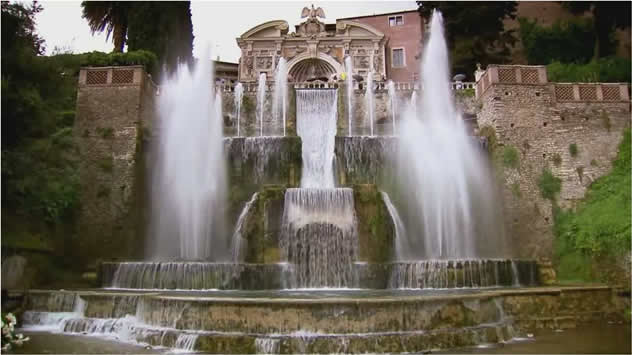Listen to part of a lecture in an art history class.
聽一段藝術史課程。
Professor: OK. We have been talking about the art and architecture of the Italian Renaissance, from around A.D. 1400 to around A.D. 1600.
教授:好了,我們已經(jīng)講過了意大利文藝復興時期(約公元1400年至1600年)的藝術和建筑。
Last class, we had a look at some of the magnificent palaces and villas built during this time period.
上節(jié)課,我們看了一些這個時期人們建造的宏偉宮殿和別墅。
And just as class was ending, someone asked about the gardens associated with these palaces and villas.
上節(jié)課結束時,有人問到這些宮殿和別墅配套的花園。
And so I'd like to say a few things about them before we move on.
所以在我們繼續(xù)往下講之前,我想就此講幾句。
Now, when I say gardens, I don't mean vegetable gardens or simple flower gardens.
當我說花園,我并不是指蔬菜園或只有鮮花的花園。

These were lavishly constructed, finely detailed gardens that covered hundreds of acres, with exotic plants and ornamental statues.
這些是造得極其精美,每個細節(jié)都非常精致的花園,有幾百英畝大,里面有外來植物和裝飾性的雕塑。
And they were just as much a symbol of their owners' social position as their palaces and villas were.
它們也正是其園主社會地位的象征,正如宮殿和別墅一樣。
Again, what was the inspiration for the Renaissance? Rebecca.
再問一次,文藝復興的靈感來源是什么?麗貝卡。
Student: Classical art and architecture of the ancient Greeks and Romans.
學生:古希臘和古羅馬的經(jīng)典藝術和建筑。
Professor: That's right.
教授:正確。
As we've said before, the main point of the Renaissance was to revive the genius of the ancient Greeks and Romans, which is why designers of Renaissance gardens designed them as the ancient Romans would have designed them, or at least as they imagined the ancient Romans would have designed them.
正如我們之前所說,文藝復興主要是為了讓古希臘和古羅馬的輝煌藝術重現(xiàn)光彩,這就是為什么文藝復興時期的花園設計師將花園設計成古羅馬人會設計成的樣子,或至少是他們想象中古羅馬人會這么設計。
Student: How did they know what ancient Roman gardens look like?
學生:他們怎么知道古羅馬的花園是什么樣子?
Professor: Well, they didn't have any pictures.
教授:他們沒有圖片。
But they did have some very detailed descriptions of ancient Roman villas and their gardens that had been written by famous Roman authors who lived during the height of the Roman Empire.
但他們有對古羅馬別墅和花園非常細節(jié)的描述,是在羅馬帝國鼎盛時期的著名羅馬作家。
And at least three of those authors, one was a scholar, one was a poet, and one was lawyer, were very authoritative, very reliable sources.
至少其中三位這樣的作者,一位是學者,一位是詩人,還有一位是律師,都是非常權威可靠的信息來源。
Ah...and interestingly enough, there was another source that didn't describe classical gardens but still became a great influence on Renaissance gardens.
很有趣的是,有另一種信息來源,沒有描述古典花園,但對文藝復興時期的花園產(chǎn)生了巨大影響。
It was also written back during the height of the Roman Empire by a mathematician known as Hero of Alexandria.
這是由一位數(shù)學家寫的,稱為“亞歷山大港的希羅”,也是生活在羅馬帝國鼎盛時期。
Hero was a Greek. But he lived in Alexandria, Egypt, which was at the time part of the Roman Empire.
希羅是希臘人,但他住在埃及的亞歷山大港,那時候隸屬羅馬帝國。
Hero compiled descriptions and sketches of seventy some clever little mechanical devices, most of which utilized compressed air to cause water, or in some cases wine, to flow from one place to another, or sometimes to squirt or to make some kind of noise. Yes? John?
希羅編繪了對70多種精巧的小機械裝置的描述和草圖,大部分裝置利用了加壓空氣來使水(一些情況下是酒)從一處流到另一處,有些時候會噴水,或發(fā)出一些聲音。約翰?
Student: Could you give an example?
學生:你能舉個例子嗎?
Professor: Well, one of the devices was a sacrificial vessel that was obviously designed for a temple, not for a garden.
教授:其中一個裝置是一種祭祀用的禮器,顯然是為了寺廟而設計的,不是用于花園里的。
Anyway, if you drop money into this vessel, water would flow out of it.
不管怎樣,如果你投錢到容器里,會有水從里面流出來。
Well, creative minds in the Renaissance realized that this little device could be nicely repurposed as a nifty little fountain.
文藝復興時期一些有創(chuàng)意的人們發(fā)現(xiàn),這個小巧的裝置能被改造成精美的小型噴泉。
Designers of Renaissance gardens loved this sort of thing.
文藝復興時期的花園設計師愛死這種設計了。
They loved to incorporate novelties and tricks, things to amuse and impress guests.
他們非常喜歡融合不同的創(chuàng)意和小花招,來娛樂和打動客人們。


